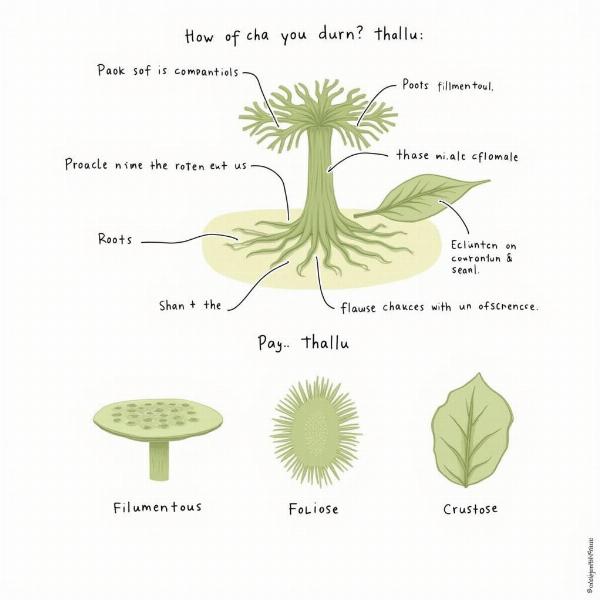Understanding the meaning of “thallus” in Hindi is crucial for anyone studying botany or exploring the world of plants, algae, and fungi. “Thallus” refers to a plant body that is not differentiated into stem, leaves, and roots. This simple structure is characteristic of many lower plants and contrasts sharply with the complex vascular systems found in higher plants. But what exactly does this mean in the context of Hindi and Indian botany? This article will delve into the various aspects of “thallus” meaning in Hindi, exploring its relevance in different biological contexts and examining its cultural significance.
Understanding “Thallus” in the Hindi Context
 Thallus Structure Diagram
Thallus Structure Diagram
In Hindi, the term most commonly used for “thallus” is “थैलस” (pronounced “thailas”), which is a direct transliteration of the English word. While there isn’t a single, perfect Hindi equivalent that captures all the nuances of “thallus,” other terms like “वनस्पति काया” (vanaspati kaya – plant body) or “अविभेदित पादप शरीर” (avibhedit paadap shareer – undifferentiated plant body) can be used in specific contexts to describe a thallus. However, “थैलस” remains the most widely accepted and understood term within scientific and educational circles. This preference for the transliterated term reflects the global nature of scientific vocabulary and the ease of communication it facilitates.
Different Types of Thalli and Their Hindi Equivalents
Thalli can take on various forms, each with its own characteristics. These forms can be broadly categorized as:
- Filamentous: Thread-like structures, often found in algae like Spirogyra. In Hindi, this can be described as “रेशेदार थैलस” (reshedaar thallus – filamentous thallus).
- Foliose: Leaf-like structures, common in certain types of algae and lichens. The Hindi equivalent could be “पत्तेदार थैलस” (pattedaar thallus – leafy thallus).
- Crustose: Crust-like structures that adhere tightly to surfaces, often seen in lichens. This type can be referred to as “पपड़ीदार थैलस” (papridaar thallus – crust-like thallus) in Hindi.
The Importance of “Thallus” in Indian Botany
“थैलस” plays a significant role in the study of Indian flora, especially in understanding the diversity of algae, fungi, and lichens. India’s varied climatic conditions support a rich array of these organisms, many of which are characterized by their thalloid structure. Studying these organisms helps us understand the ecological balance and the intricate relationships within these ecosystems.
Dr. Anjali Sharma, a renowned botanist from the Indian Institute of Science, Bangalore, shares her perspective: “The study of thallophytes, organisms with a thallus, is essential for understanding the evolutionary history of plants. These organisms provide valuable insights into the early stages of plant development and adaptation.”
“Thallus” in Everyday Life
While “thallus” might sound like a purely scientific term, its implications extend to our everyday lives. For instance, many types of edible seaweed, consumed widely in coastal regions of India, are thallophytes. Understanding the structure and properties of these algae is crucial for both culinary and nutritional purposes.
Conclusion
Understanding the “thallus meaning in Hindi” (थैलस का अर्थ हिंदी में) unlocks a deeper appreciation for the diversity of plant life and its significance in various contexts. From scientific research to everyday applications, “थैलस” plays a crucial role in our understanding of the natural world.
FAQ
-
What is the simplest definition of “thallus” in Hindi? थैलस एक पौधे का शरीर है जिसमें तना, पत्तियां और जड़ें नहीं होती हैं। (Thallus ek paudhe ka shareer hai jismein tana, pattiyan aur jaden nahin hoti hain – A thallus is a plant body that doesn’t have stem, leaves, and roots.)
-
Why is it important to understand “thallus”? Understanding “thallus” is crucial for studying lower plants and understanding their role in the ecosystem.
-
Are all algae and fungi considered thallophytes? Yes, most algae and fungi have a thallus and are therefore classified as thallophytes.
-
Can “thallus” be used to describe any plant body? No, “thallus” specifically refers to an undifferentiated plant body lacking distinct roots, stem, and leaves.
-
Where can I find more information about “thallus” and thallophytes? You can find more information in botany textbooks, online resources, and scientific publications.
-
What is the significance of “thallus” in Indian culture? While not directly culturally significant, the understanding of “thallus” is important for appreciating the diversity of plant life in India, especially in coastal regions where seaweed is consumed.
-
What are some common examples of thallophytes in India? Some common examples include various types of seaweed, lichens, and certain fungi.
Meaning-Hindi.in is your trusted partner for all your Hindi translation needs. We specialize in providing accurate and culturally sensitive translations for a wide range of documents, from business and legal materials to technical manuals and educational resources. Our team of expert linguists ensures that your message is conveyed effectively and respectfully in Hindi and other languages. We also offer specialized services such as website localization, ensuring your online presence resonates with your target audience. Need a quick turnaround? Our express translation services are designed to meet tight deadlines without compromising quality. Contact us today at [email protected] or call us at +91 11-4502-7584 to discuss your translation requirements. Meaning-Hindi.in is committed to delivering high-quality language solutions that bridge cultural gaps and facilitate effective communication.